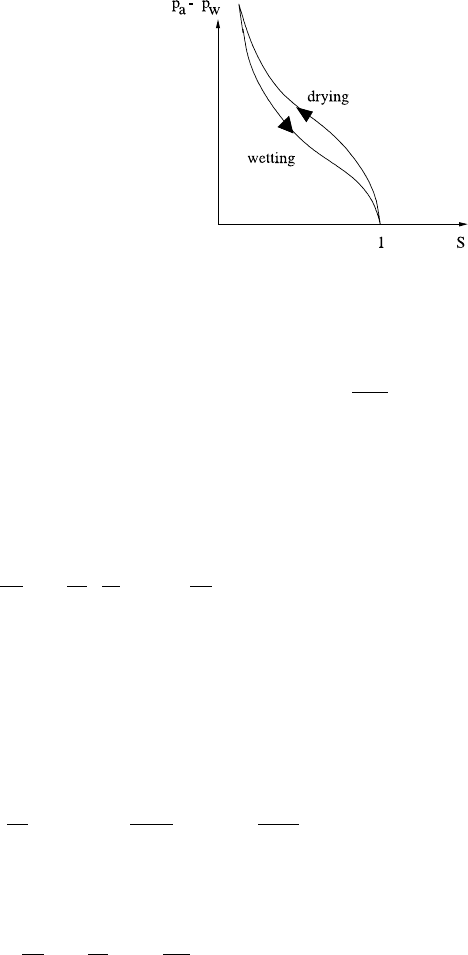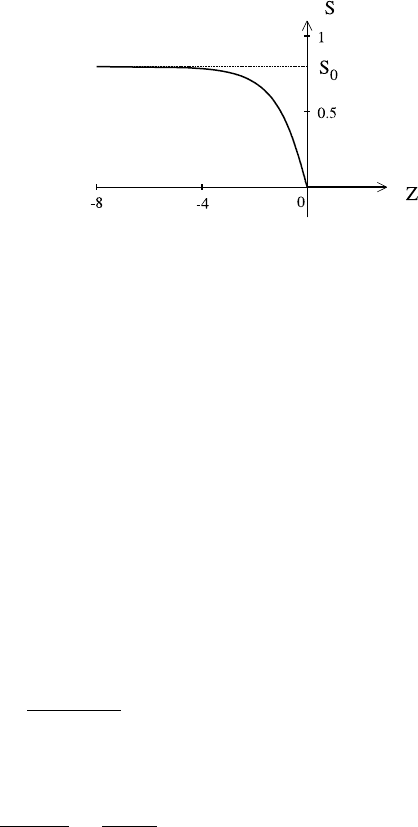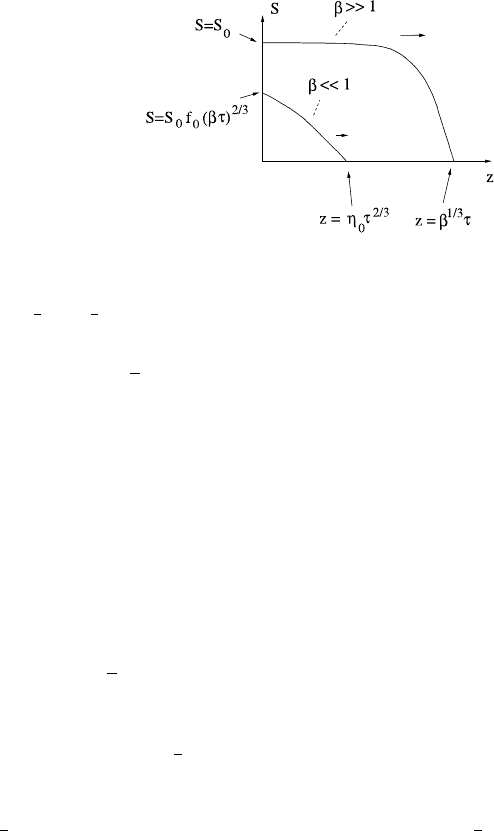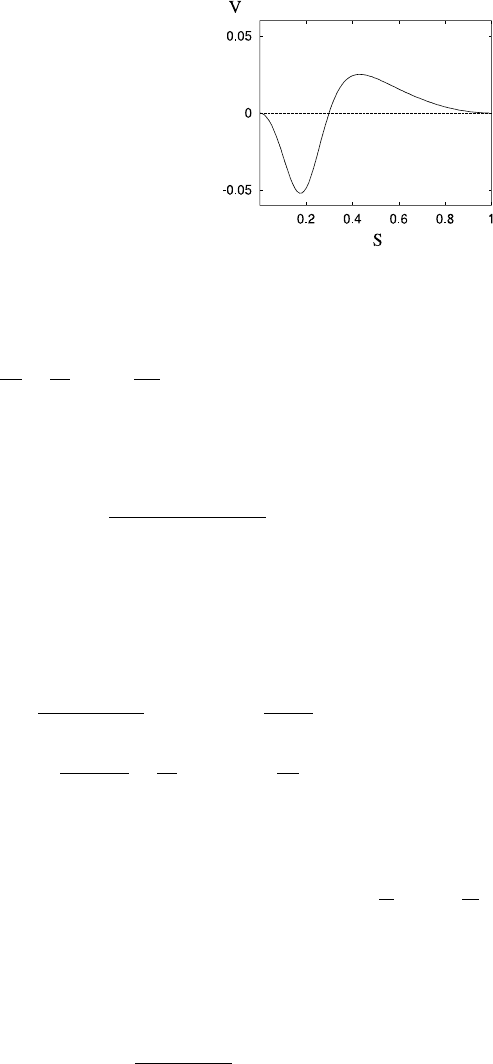Fowler A. Mathematical Geoscience
Подождите немного. Документ загружается.


400 7 Groundwater Flow
Fig. 7.4 Capillary suction
characteristic. It displays
hysteresis in wetting and
drying
where
ˆ
k is a unit vector upwards, and the permeability k depends on S.Ifk(1) =k
0
(the saturated permeability), then one commonly writes k = k
0
k
rw
(S), where k
rw
is the relative permeability. The most obvious assumption would be k
rw
= S,but
this is rarely appropriate, and a better representation is a convex function, such as
k
rw
=S
3
. An even better representation is a function such as k
rw
=(
S−S
0
1−S
0
)
3
+
, where
S
0
is known as the residual saturation. It represents the fact that in fine-grained
soils, there is usually some minimal water fraction which cannot be removed. It is
naturally associated with a capillary suction characteristic function p
a
−p =f(S)
which tends to infinity as S →S
0
+, also appropriate for fine-grained soils.
In one dimension, and if we take the vertical coordinate z to point downwards,
we obtain the Richards equation
φ
∂S
∂t
=−
∂
∂z
k
0
μ
k
rw
(S)
∂f
∂z
+ρg
. (7.56)
We are assuming p
a
= constant (and also that the soil matrix is incompressible).
7.3.2 Non-dimensionalisation
We choose scales for the variables as follows:
f =
σ
d
p
ψ, z ∼
σ
ρgd
p
,t∼
φμz
ρgk
0
, (7.57)
where d
p
is grain size and σ is the surface tension, assumed constant. The Richards
equation then becomes, in dimensionless variables,
∂S
∂t
=−
∂
∂z
k
rw
∂ψ
∂z
+1
. (7.58)
To be specific, we consider the case of soil wetting due to surface infiltration: of
rainfall, for example. Suitable boundary conditions for infiltration are
S =1atz =0 (7.59)

7.3 Unsaturated Soils 401
if surface water is ponded, or
k
rw
∂ψ
∂z
+1
=u
∗
=
μu
0
k
0
ρ
w
g
=
u
0
K
0
, (7.60)
if there is a prescribed downward flux u
0
; K
0
is the saturated hydraulic conduc-
tivity. In a dry soil we would have S → 0asz →∞,orifthereisawatertable
at z = z
p
, S = 1 there.
5
For silt with k
0
= 10
−14
m
2
, the hydraulic conductivity
K
0
∼ 10
−7
ms
−1
or 3 m y
−1
, while average rainfall in England, for example, is
≤1my
−1
. Thus on average u
∗
≤ 1, but during storms we can expect u
∗
1. For
large values of u
∗
, the desired solution may have S>1atz =0; in this case ponding
occurs (as one observes), and (7.60) is replaced by (7.59), with the pond depth being
determined by the balance between accumulation, infiltration, and surface run-off.
7.3.3 Snow Melting
An application of the unsaturated flow model occurs in the study of melting snow.
In particular, it is found that pollutants which may be uniformly distributed in snow
(e.g. SO
2
from sulphur emissions via acid rain) can be concentrated in melt wa-
ter run-off, with a consequent enhanced detrimental effect on stream pollution. The
question then arises, why this should be so. We shall find that uniform surface melt-
ing of a dry snowpack can lead to a meltwater spike at depth.
Suppose we have a snow pack of depth d. Snow is a porous aggregate of ice
crystals, and meltwater formed at the surface can percolate through the snow pack
to the base, where run-off occurs. (We ignore effects of re-freezing of meltwater.)
The model (7.58) is appropriate, but the relevant length scale is d. Therefore we
define a parameter
κ =
σ
ρgdd
p
, (7.61)
and we rescale the variables as z ∼1/κ, t ∼1/κ. To be specific, we will also take
k
rw
=S
3
, (7.62)
and
ψ(S)=
1
S
−S, (7.63)
based on typical experimental results.
Suitable boundary conditions in a melting event might be to prescribe the melt
flux u
0
at the surface, thus
k
rw
∂ψ
∂z
+1
=u
∗
=
u
0
K
0
at z =0. (7.64)
5
With constant air pressure, continuity of S follows from continuity of pore water pressure.

402 7 Groundwater Flow
If the base is impermeable, then
k
rw
∂ψ
∂z
+1
=0atz =h. (7.65)
This is certainly not realistic if S reaches 1 at the base, since then ponding must
occur and presumably melt drainage will occur via a channelised flow, but we ex-
amine the initial stages of the flow using (7.65). Finally, we suppose S =0att =0.
Again, this is not realistic in the model (it implies infinite capillary suction) but it is
a feasible approximation to make.
Simplification of this model now leads to the dimensionless Darcy–Richards
equation in the form
∂S
∂t
+3S
2
∂S
∂z
=κ
∂
∂z
S
1 +S
2
∂S
∂z
. (7.66)
If we choose σ = 70 mN m
−1
, d
p
= 0.1 mm, ρ = 10
3
kg m
−3
, g = 10 m s
−2
,
d = 1 m, then κ = 0.07. It follows that (7.66) has a propensity to form shocks,
these being diffused by the term in κ over a distance O(κ) (by analogy with the
shock structure for the Burgers equation, see Chap. 1).
We want to solve (7.66) with the initial condition
S =0att =0, (7.67)
and the boundary conditions
S
3
−κS
1 +S
2
∂S
∂z
=u
∗
on z =0, (7.68)
and
S
3
−κS
1 +S
2
∂S
∂z
=0atz =1. (7.69)
Roughly, for κ 1, these are
S =S
0
at z =0,
S =0atz =1,
(7.70)
where S
0
=u
∗1/3
, which we initially take to be O(1) (and <1, so that surface pond-
ing does not occur).
Neglecting κ, the solution is the step function
S =S
0
,z<z
f
,
S =0,z>z
f
,
(7.71)
and the shock front at z
f
advances at a rate ˙z
f
given by the jump condition
˙z
f
=
[S
3
]
+
−
[S]
+
−
=S
2
0
. (7.72)

7.3 Unsaturated Soils 403
Fig. 7.5 S(Z) given by
(7.78); the shock front
terminates at the origin
In dimensional terms, the shock front moves at speed u
0
/φS
0
, which is in fact ob-
vious (given that it has constant S behind it).
The shock structure is similar to that of Burgers’ equation. We put
z =z
f
+κZ, (7.73)
and S rapidly approaches the quasi-steady solution S(Z) of
−VS
+3S
2
S
=
S
1 +S
2
S
, (7.74)
where V =˙z
f
; hence
S
1 +S
2
S
=−S
S
2
0
−S
2
, (7.75)
in order that S →S
0
as Z →−∞, and where we have chosen
V =S
2
0
, (7.76)
(as S
+
=0), thus reproducing (7.72). The solution is a quadrature,
S
(1 +S
2
)dS
(S
2
0
−S
2
)
=−Z, (7.77)
with an arbitrary added constant (amounting to an origin shift for Z). Hence
S −
(1 +S
2
0
)
2S
0
ln
S
0
+S
S
0
−S
=Z. (7.78)
The shock structure is shown in Fig. 7.5; the profile terminates where S = 0at
Z = 0. In fact, (7.75) implies that S = 0or(7.78) applies. Thus when S given by
(7.78) reaches zero, the solution switches to S = 0. The fact that ∂S/∂Z is discon-
tinuous is not a problem because the diffusivity S(1 +S
2
) goes to zero when S =0.
This degeneracy of the equation is a signpost for fronts with discontinuous deriva-
tives: essentially, the profile can maintain discontinuous gradients at S = 0 because
the diffusivity is zero there, and there is no mechanism to smooth the jump away.
Suppose now that k
0
= 10
−10
m
2
and μ/ρ = 10
−6
m
2
s
−1
; then the satu-
rated hydraulic conductivity K
0
= k
0
ρg/μ = 10
−3
ms
−1
. On the other hand, if

404 7 Groundwater Flow
a metre thick snow pack melts in ten days, this implies u
0
∼ 10
−6
ms
−1
. Thus
S
3
0
=u
0
/K
0
∼10
−3
, and the approximation S ≈S
0
looks less realistic. With
S
3
−κS
1 +S
2
∂S
∂z
=S
3
0
, (7.79)
and S
0
∼10
−1
and κ ∼10
−1
, it seems that one should assume S 1. We define
S =
S
3
0
κ
1/2
s; (7.80)
(7.79) becomes
βs
3
−s
1 +
S
3
0
κ
s
2
∂s
∂z
=1onz =0, (7.81)
and we have S
3
0
/κ ∼10
−2
, β =(S
0
/κ)
3/2
∼1.
We neglect the term in S
3
0
/κ, so that
βs
3
−s
∂s
∂z
≈1onz =0, (7.82)
and substituting (7.80)into(7.66) leads to
∂s
∂τ
+3βs
2
∂s
∂z
≈
∂
∂z
s
∂s
∂z
, (7.83)
if we define t = τ/(κS
3
0
)
1/2
. A simple analytic solution is no longer possible, but
the development of the solution will be similar. The flux condition (7.82)atz = 0
allows the surface saturation to build up gradually, and a shock will only form if
β 1 (when the preceding solution becomes valid).
7.3.4 Similarity Solutions
If, on the other hand, β 1, then the saturation profile approximately satisfies
∂s
∂τ
=
∂
∂z
s
∂s
∂z
,
−s
∂s
∂z
=
1onz =0,
0onz =1.
(7.84)
At least for small times, the model admits a similarity solution of the form
s =τ
a
f(η), η=z/τ
b
, (7.85)

7.3 Unsaturated Soils 405
Fig. 7.6 Schematic
representation of the
evolution of S for both large
and small β
where satisfaction of the equations and boundary conditions requires 2a = b and
2b =1 =a, whence a =
1
3
, b =
2
3
, and f satisfies
(ff
)
−
1
3
(f −2ηf
) =0, (7.86)
with the condition at z =0 becoming
−ff
=1atη =0. (7.87)
The condition at z = 1 can be satisfied for small enough τ, as we shall see, be-
cause Eq. (7.86) is degenerate, and f reaches zero in a finite distance, η
0
, say, and
f =0forη>η
0
.Asη =1/τ
2/3
at z =1, then this solution will satisfy the no flux
condition at z =1 as long as τ<η
−3/2
0
, when the advancing front will reach z =1.
To see why f behaves in this way, integrate once to find
f
f
+
2
3
η
=−1 +
η
0
fdη. (7.88)
For small η, the right hand side is negative, and f is positive (to make physical
sense), so f decreases (and in fact f
< −
2
3
η). For sufficiently small f(0) = f
0
, f
will reach zero at a finite distance η = η
0
, and the solution must terminate. On the
other hand, for sufficiently large f
0
,
η
0
fdηreaches 1 at η = η
1
while f is still
positive (and f
=−
2
3
η
1
there). For η>η
1
, then f remains positive and f
> −
2
3
η
(f cannot reach zero for η>η
1
since
η
0
fdη>1forη>η
1
). Eventually f must
have a minimum and thereafter increase with η. This is also unphysical, so we re-
quire f to reach zero at η = η
0
. This will occur for a range of f
0
, and we have to
select f
0
in order that
η
0
0
fdη=1, (7.89)
which in fact represents global conservation of mass. Figure 7.6 shows the schematic
form of solution both for β 1 and β 1. Evidently the solution for β ∼ 1 will
have a profile with a travelling front between these two end cases.

406 7 Groundwater Flow
7.4 Immiscible Two-Phase Flows: The Buckley–Leverett
Equation
In some circumstances, the flow of more than one phase in a porous medium is
important. The type example is the flow of oil and gas, or oil and water (or all three!)
in a sedimentary basin, such as that beneath the North Sea. Suppose there are two
phases; denote the phases by subscripts 1 and 2, with fluid 2 being the wetting fluid,
and S is its saturation. Then the capillary suction characteristic is
p
1
−p
2
=p
c
(S), (7.90)
with the capillary suction p
c
being a positive, monotonically decreasing function of
saturation S; mass conservation takes the form
−φ
∂S
∂t
+∇.u
1
=0,
φ
∂S
∂t
+∇.u
2
=0,
(7.91)
where φ is (constant) porosity, and Darcy’s law for each phase is
u
1
=−
k
0
μ
1
k
r1
[∇p
1
+ρ
1
g
ˆ
k],
u
2
=−
k
0
μ
2
k
r2
[∇p
2
+ρ
2
g
ˆ
k],
(7.92)
with k
ri
being the relative permeability of fluid i.
For example, if we consider a one-dimensional flow, with z pointing upwards,
then we can integrate (7.91) to yield the total flux
u
1
+u
2
=q(t). (7.93)
If we define the mobilities of each fluid as
M
i
=
k
0
μ
i
k
ri
, (7.94)
then it is straightforward to derive the equation for S,
φ
∂S
∂t
=−
∂
∂z
M
eff
q
M
1
+
∂p
c
∂z
+(ρ
1
−ρ
2
)g
, (7.95)
where the effective mobility is determined by
M
eff
=
1
M
1
+
1
M
2
−1
. (7.96)

7.4 Immiscible Two-Phase Flows: The Buckley–Leverett Equation 407
Fig. 7.7 Graph of
dimensionless wave speed
V(S)as a function of wetting
fluid saturation, indicating the
speed and direction of wave
motion (V>0 means waves
move upwards) if the wetting
fluid is more dense. The
viscosity ratio μ
r
(see
(7.100))istakentobe30
This is a convective-diffusion equation for S. If suction is very small, we obtain
the Buckley–Leverett equation
φ
∂S
∂t
+
∂
∂z
M
eff
q
M
1
+(ρ
1
−ρ
2
)g
=0, (7.97)
which is a nonlinear hyperbolic wave equation. As a typical situation, suppose
q =0, and k
r2
=S
3
, k
r1
=(1 −S)
3
. Then
M
eff
=
k
0
S
3
(1 −S)
3
μ
1
S
3
+μ
2
(1 −S)
3
, (7.98)
and the wave speed v(S) is given by
v =−(ρ
2
−ρ
1
)gM
eff
(S) =v
0
V(S), (7.99)
where
v
0
=
(ρ
2
−ρ
1
)gk
0
μ
2
,V(S)=
χ
(S)
χ(S)
2
,
χ(S)=
μ
r
(1 −S)
3
+
1
S
3
,μ
r
=
μ
1
μ
2
.
(7.100)
The variation of V with S is shown in Fig. 7.7.Forρ
2
>ρ
1
(as for oil and water,
where water is the wetting phase), waves move upwards at low water saturation and
downwards at high saturation.
Shocks will form, but these are smoothed by the diffusion term −
∂
∂z
[M
eff
p
c
∂S
∂z
],
in which the diffusion coefficient is
D =−M
eff
p
c
. (7.101)
As a typical example, take
p
c
=
p
0
(1 −S)
λ
1
S
λ
2
(7.102)

408 7 Groundwater Flow
with λ
i
> 0. Then we find
D =k
0
p
0
S
2−λ
2
(1 −S)
2+λ
1
λ
1
S +λ
2
(1 −S)
μ
1
S
3
+μ
2
(1 −S)
3
, (7.103)
and we see that D is typically degenerate at S = 0. In particular, if λ
2
< 2, then
infiltration of the wetting phase into the non-wetting phase proceeds at a finite rate,
and this always occurs for infiltration of the non-wetting phase into the wetting
phase.
A particular limiting case is when one phase is much less dense than the other,
the usual situation being that of gas and liquid. This is exemplified by the problem
of snow-melt run-off considered earlier. In that case, water is the wetting phase, thus
ρ
2
−ρ
1
= ρ
w
−ρ
a
is positive, and also μ
w
≈ 10
−3
Pa s, μ
a
≈ 10
−5
Pa s, whence
μ
a
μ
w
(μ
r
1), so that, from (7.98),
M
eff
≈
k
0
S
3
μ
w
, (7.104)
at least for saturations not close to unity. Shocks form and propagate downwards
(since ρ
2
>ρ
1
). The presence of non-zero flux q<0 does not affect this statement.
Interestingly, the approximation (7.104) will always break down at sufficiently high
saturation. Inspection of V(S) for μ
r
= 0.01 (as for air and water) indicates that
(7.104) is an excellent approximation for S 0.5, but not for S 0.6; for S 0.76,
V is positive and waves move upwards. As μ
r
→0, the right hand hump in Fig. 7.7
moves towards S = 1, but does not disappear; indeed the value of the maximum
increases, and is V ∼ μ
−1/3
r
. Thus the single phase approximation for unsaturated
flow is a singular approximation when μ
r
1 and 1 −S 1.
7.5 Heterogeneous Porous Media
Perhaps the major concern in groundwater studies concerns the permeability.
Whereas we tend to think of the permeability as a well-defined quantity which re-
flects the local soil or rock properties, in reality it varies over many orders of mag-
nitude on very small length scales. The consequence of this is that the value of the
permeability itself needs to be averaged in some way.
Permeability is so variable because of soil and rock heterogeneity. Because it
scales with the square of the constituent grain size, clay and sand permeabilities are
vastly different. And because sediments are lain down so slowly, over millions of
years, sand and clay layers often lie in close proximity. The same is true for sedi-
mentary rocks, which are simply the same sand and clay layers cemented together
after burial and consequent subjection to high pressure and temperature.
In seeking to quantify porous medium flow at the large scale, we need to av-
erage the permeability in some way at the mesoscale: larger than the pore scale,
but less than the macroscale. The simplest approach is to suppose that the per-
7.5 Heterogeneous Porous Media 409
meability in a mesoscale block has a random distribution, often assumed to be
a lognormal distribution. An averaged permeability can be derived by supposing,
for example, that fluctuations have small amplitude. One finds that the consequent
averaged permeability is a tensor, whose components depend on the direction of
flow. In the following section, we consider a more specific model of the mesoscale
structure, where the heterogeneity is related to the occurrence of fractures in the
medium. This leads to the idea of a secondary porosity associated with the frac-
tures.
7.5.1 Dual Porosity Models
Take a walk on exposed basement rock: at the seaside, in the mountains. Rocks are
not uniform, but are inevitably fractured, or jointed. There are numerous reasons for
this. Sedimentary rocks are lain down over millions of years via the deposition of
outwash clays, sands or calcareous microfossils in marine environments. Over this
time the deposition rate may average a millimetre or less per year. A metre of rock
may take a million, or ten million years, to accumulate. In this time, sea level may
rise or fall by tens or more of metres, and the land itself rises or falls because of
tectonic processes: the crashing of continents, the uplift of mountains, the burial of
sedimentary basins.
It is no surprise that in an exposed sedimentary sequence, such as one sees in
coastal cliffs, rocks form stratigraphic layers separated by unconformities marking
different sedimentary epochs. These unconformities are layers of weakness, and
when the rocks are later subjected to tectonic compression and folding, fractures
will form.
It is not only sedimentary rocks which tear as they are stressed. Igneous rocks
fracture as they solidify because of solidification shrinkage. They also form intru-
sions such as dikes and sills, whose different erosional properties can cause subse-
quent voidage.
The occurrence of faulting or jointing in rocks leads to a particular problem in the
description of groundwater flow through them. The rock itself is porous, and admits
a Darcy flow through its pore space; but the fractures act as a second porosity, ad-
mitting a secondary flow which would occur even if the rock itself was completely
impermeable. The situation is illustrated in Fig. 7.8. It is because of this configura-
tion that the system is called a double, or dual, porosity system, and the resulting
model to describe the flow is called a dual porosity model.
In order to characterise porous flow through such a medium, we distinguish be-
tween the blocks of the matrix and the cross-cutting fractures. We suppose the frac-
tures are tabular, or planar, of width h, and the blocks are of dimension d
B
, and
that h d
B
. We denote the blocks by the domain M, and the fractures as ∂M.Be-
cause the fractures are narrow, ∂M essentially represents the external surfaces of
the blocks. We also suppose that d
B
l, where l is a relevant macroscopic length
